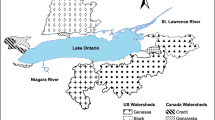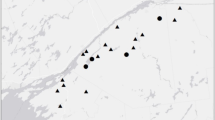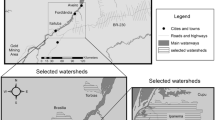Abstract
Although there have been recent significant gains in our understanding of mercury (Hg) cycling in aquatic environments, few studies have addressed Hg cycling on a watershed scale. In particular, attention to Hg species transfer between watershed components (upland soils, groundwater, wetlands, streams, and lakes) has been lacking. This study describes spatial and temporal distributions of total Hg and MeHg among watershed components of the Allequash Creek watershed (northern Wisconsin, USA). Substantial increases in total Hg and MeHg were observed as groundwater discharged through peat to form springs that flow into the stream, or rivulets that drain across the surface of the wetland. This increase was concomitant with increases in DOC. During fall, when the Allequash Creek wetland released a substantial amount of DOC to the stream, a 2–3 fold increase in total Hg concentrations was observed along the entire length of the stream. Methylmercury, however, did not show a similar response. Substantial variability was observed in total Hg (0.9 to 6.3) and MeHg (<0.02 to 0.33) concentrations during synoptic surveys of the entire creek. For the Allequash Creek watershed, the contributing groundwater basin is about 50% larger than the topographic drainage basin. Total Hg concentrations in groundwater, the area of the groundwater basin, and annual stream flow data give a watershed-yield rate of 1.2 mg/km2/d, which equates to a retention rate of 96%. The calculated MeHg yield rate for the wetland area is 0.6 to 1.5 mg/km2/d, a value that is 3–6 fold greater than the atmospheric deposition rate.
Similar content being viewed by others
References
Aastrup, M., Johnson, J., Bringmark, E., Bringmark, I., Iverfeldt, A.. 1991,Water, Air, and Soil Pollut., 56, 155–167.
Anderson, M.P., and Munter, J.A., 1981,Water Resour. Res., 17, 1139–1150.
Anderson, M.P., and Hunt, R.J., 1994, Proceedings of:Analytic Element Modeling of Groundwater Flow, April 19–21, 1994, Indianapolis, Indiana, program with abstracts.
Andren, A.W., Benoit, J.M., Babiarz, C.L., Shafer, M.M., Hurley, J.P., and Krabbenhoft, D.P., 1994, Proceedings of:International Conference on Mercury as a Global Pollutant, Whistler, B.C., Canada, July 10–14, 1994, program with abstracts.
Bloom, N.S., and Fitzgerald, 1988,Anal. Chim. Acta, 208, 151–161.
Fitzgerald, W.F., R.P. Mason, and Vandal, G.M., 1991,Water, Air, and Soil Pollut., 56, 745–768.
Horvat, M., Bloom, N.S., and Liang, L., 1993, Anal. Chim. Acta, 282, 153-lxx.
Hurley, J.P., Benoit, J.M., Babiarz, C.L., Andren, A.W., and Webb, D.A., 1994a, Proceedings of:International Conference on Mercury as a Global Pollutant, Whistler, B.C., Canada, July 10–14, 1994, program with abstracts.
Hurley, J.P., Krabbenhoft, D.P., Babiarz, C.L., and Andren, A.W., 1994b,Cycling of Mercury across the Sediment-Water Interface in Seepage Lakes, in: Environmental Chemistry of Lakes and Reservoirs, (Baker, L., ed), Amer. Chem. Soc., 425–449.
Hurley, J.P., Watras, C.J, and Bloom, N.S., 1994c,Distribution and Fluxes of Particulate Mercury in Four Stratified Seepage Lakes, in: Mercury Pollution: Integration and Synthesis (Watras, C.J., and Huckabee, J.W., eds.), Lewis Publishers.
Krabbenhoft, D.P., 1988,Hydrologic and Geochemical Investigations of Aquifer-Lake Interactions at Sparkling Lake, Wisconsin, Ph.D. Thesis, Uni. Wisc., 213 p.
Krabbenhoft, D.P., Anderson, M.P., and Bowser, C.J., 1990,Water Resour. Res., 26, 2455–2462.
Krabbenhoft, D.P. and Babiarz, C.L.: 1992,Water Resour. Res., 28, 3119–3128.
Lindqvist, O., Johansson, K., Aastrup, M., Andersson, A., Bringmark, L., Hovenius, G., Hakanson, L., Iverfeldt, A., Meili, M., and Timm, B., 1991,Water, Air, and Soil Pollut., 55, 1–261.
Mierle, G., 1990, Environ. Toxicol. Chem., 9, 843–851.
St. Louis, V.L., Rudd, J.W.M., Kelly, C.A., Beaty, K.G., Bloom, N.S., and Flett, R.J., 1994,Can. J. Fish. Aquat. Sci., 51, in press.
Swain, E.B., Engstrom, D.R., Brigham, M.E., Henning, T.A., and Brezonik, P.L., 1992,Science, 257, 784–787.
Watras, C.J., and Hukabee, J.W., 1994,Mercury Pollution, Synthesis and Integration, Lewis Pub.
Author information
Authors and Affiliations
Rights and permissions
About this article
Cite this article
Krabbenhoft, D.P., Benoit, J.M., Babiarz, C.L. et al. Mercury cycling in the Allequash Creek watershed, northern Wisconsin. Water Air Soil Pollut 80, 425–433 (1995). https://doi.org/10.1007/BF01189692
Issue Date:
DOI: https://doi.org/10.1007/BF01189692




